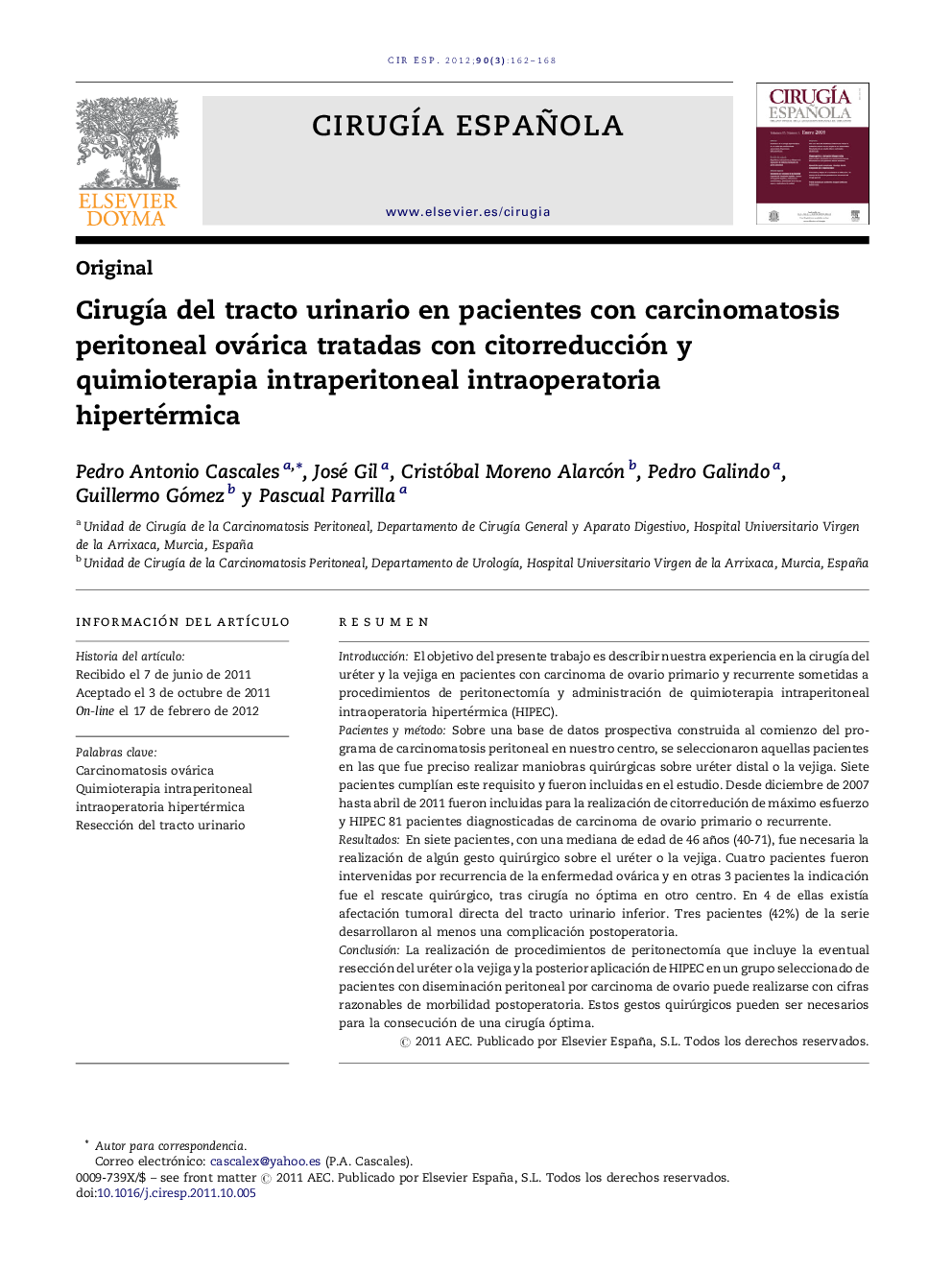| Article ID | Journal | Published Year | Pages | File Type |
|---|---|---|---|---|
| 4252957 | Cirugía Española | 2012 | 7 Pages |
ResumenIntroducciónEl objetivo del presente trabajo es describir nuestra experiencia en la cirugía del uréter y la vejiga en pacientes con carcinoma de ovario primario y recurrente sometidas a procedimientos de peritonectomía y administración de quimioterapia intraperitoneal intraoperatoria hipertérmica (HIPEC).Pacientes y métodoSobre una base de datos prospectiva construida al comienzo del programa de carcinomatosis peritoneal en nuestro centro, se seleccionaron aquellas pacientes en las que fue preciso realizar maniobras quirúrgicas sobre uréter distal o la vejiga. Siete pacientes cumplían este requisito y fueron incluidas en el estudio. Desde diciembre de 2007 hasta abril de 2011 fueron incluidas para la realización de citorredución de máximo esfuerzo y HIPEC 81 pacientes diagnosticadas de carcinoma de ovario primario o recurrente.ResultadosEn siete pacientes, con una mediana de edad de 46 años (40-71), fue necesaria la realización de algún gesto quirúrgico sobre el uréter o la vejiga. Cuatro pacientes fueron intervenidas por recurrencia de la enfermedad ovárica y en otras 3 pacientes la indicación fue el rescate quirúrgico, tras cirugía no óptima en otro centro. En 4 de ellas existía afectación tumoral directa del tracto urinario inferior. Tres pacientes (42%) de la serie desarrollaron al menos una complicación postoperatoria.ConclusiónLa realización de procedimientos de peritonectomía que incluye la eventual resección del uréter o la vejiga y la posterior aplicación de HIPEC en un grupo seleccionado de pacientes con diseminación peritoneal por carcinoma de ovario puede realizarse con cifras razonables de morbilidad postoperatoria. Estos gestos quirúrgicos pueden ser necesarios para la consecución de una cirugía óptima.
IntroductionThe objective of the present work is to describe our experience in the surgery of the ureter and bladder in patients with primary and recurrent ovarian cancer subjected to peritonectomy procedures and the administration of hyperthermic intraoperative intraperitoneal chemotherapy (HIIC).Patients and methodThose patients who required surgical procedures on the distal ureter or bladder, were selected from a prospective data base constructed at the beginning of the peritoneal carcinomatosis program in our centre. Seven patients fulfilled this requirement and were included in the study. A total of 81 patients diagnosed with primary or recurrent ovarian cancer from December 2007 to April 2011 were included for maximum effort cytoreduction and HIIC.ResultsIt was necessary to perform some surgical manoeuvre on the ureter or bladder in seven patients, with a median age of 46 years (40-71). Four patients were operated on due to recurrence of the ovarian disease and in the other 3 patients the indication was surgical rescue after non-optimal surgery in another centre. There was direct tumour involvement of the lower urinary tract in 4 of them. Three patients (42%) in the series developed at least one postoperative complication.ConclusionThe performing of peritonectomy procedures that include the eventual resection of the ureter or bladder, and the subsequent application of HIIC in a selected group of patients with peritoneal dissemination due to an ovarian carcinoma can be done with reasonable rates of postoperative morbidity. These surgical procedures may be necessary to achieve optimal surgery.
